Introduction to mri - Study guides, Class notes & Summaries
Looking for the best study guides, study notes and summaries about Introduction to mri? On this page you'll find 506 study documents about Introduction to mri.
Page 3 out of 506 results
Sort by
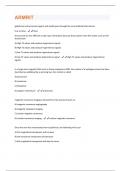
-
ARMRIT QUESTIONS WITH 100% CORRECT ANSWERS!!
- Exam (elaborations) • 53 pages • 2024
-
- $7.99
- + learn more
gadolinium enhancement agents will readily pass through the normal blood brain barrier true or false - false tissues that are less efficient at spin-spin interactions because they contain more free water, such as CSF, should have A) High T2 values and produce hypointense signals B) HIgh T2 values and produce hyperintense signals C) low T2 values and produce hypointnese signals D) low T2 values and produce hyperintense signal - High T2 values and produce hyperintense signals in a large m...
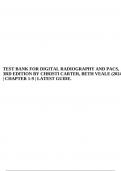
-
TEST BANK FOR DIGITAL RADIOGRAPHY AND PACS, 3RD EDITION BY CHRISTI CARTER, BETH VEALE (2024) | CHAPTER 1-9 | LATEST GUIDE.
- Exam (elaborations) • 62 pages • 2024
-
- $22.99
- + learn more
TEST BANK FOR DIGITAL RADIOGRAPHY AND PACS, 3RD EDITION BY CHRISTI CARTER, BETH VEALE (2024) | CHAPTER 1-9 | LATEST GUIDE. Chapter 01: Introduction to Digital Radiography and Picture Archiving and Communication Systems Carter: Digital Radiography and PACS, 3rd Edition MULTIPLE CHOICE 1. Film and intensifying screens are primarily used in a. computed radiography (CR). b. digital radiography (DR). c. conventional radiography. d. picture archival and communication systems. e. 2. ANS: C...
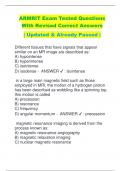
-
ARMRIT Exam Tested Questions With Revised Correct Answers | Updated & Already Passed |
- Exam (elaborations) • 72 pages • 2024
-
- $16.34
- + learn more
ARMRIT Exam Tested Questions With Revised Correct Answers | Updated & Already Passed | Different tissues that have signals that appear similar on an MR image are described as: A) hypointense B) hyperintense C) isointense D) isodense - ANSWER : isointense in a large main magnetic field such as those employed in MRI, the motion of a hydrogen proton has been described as wobbling like a spinning top. this motion is called A) precession B) resonance C) frequency D) angular mom...
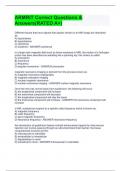
-
ARMRIT Correct Questions & Answers(RATED A+)
- Exam (elaborations) • 36 pages • 2024
-
- $14.99
- + learn more
Different tissues that have signals that appear similar on an MR image are described as: A) hypointense B) hyperintense C) isointense D) isodense - ANSWER isointense in a large main magnetic field such as those employed in MRI, the motion of a hydrogen proton has been described as wobbling like a spinning top. this motion is called A) precession B) resonance C) frequency D) angular momentum - ANSWER precession magnetic resonance imaging is derived from the process known as: A) ma...
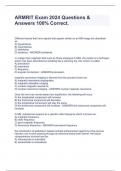
-
ARMRIT Exam 2024 Questions & Answers 100% Correct.
- Exam (elaborations) • 36 pages • 2024
- Available in package deal
-
- $17.49
- + learn more
Different tissues that have signals that appear similar on an MR image are described as: A) hypointense B) hyperintense C) isointense D) isodense - ANSWER-isointense in a large main magnetic field such as those employed in MRI, the motion of a hydrogen proton has been described as wobbling like a spinning top. this motion is called A) precession B) resonance C) frequency D) angular momentum - ANSWER-precession magnetic resonance imaging is derived from the process known as: A) ma...
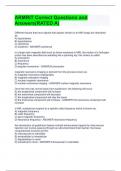
-
ARMRIT Correct Questions and Answers(RATED A)
- Exam (elaborations) • 36 pages • 2024
- Available in package deal
-
- $12.49
- + learn more
ARMRIT Correct Questions and AnswDifferent tissues that have signals that appear similar on an MR image are described as: A) hypointense B) hyperintense C) isointense D) isodense - ANSWER isointense in a large main magnetic field such as those employed in MRI, the motion of a hydrogen proton has been described as wobbling like a spinning top. this motion is called A) precession B) resonance C) frequency D) angular momentum - ANSWER precession magnetic resonance imaging is derived f...
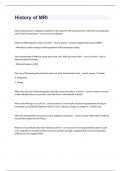
-
package deal of MRI.
- Package deal • 8 items • 2024
-
- $19.99
- + learn more
1 Exam (elaborations) History of MRI Research Study. 2 Exam (elaborations) MRI paragraph Verified Exam A+ Score. 3 Exam (elaborations) Introduction to MRI Exam Solution. 4 Exam (elaborations) Chapter 20: MAGNETIC RESONANCE IMAGING (MRI) Questions And Answers. 5 Exam (elaborations) MRI basics Study Exam. 6 Exam (elaborations) MRI chapter 1: Bas
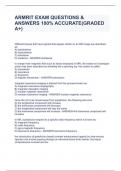
-
ARMRIT EXAM QUESTIONS & ANSWERS 100% ACCURATE(GRADED A+)
- Exam (elaborations) • 36 pages • 2024
- Available in package deal
-
- $11.99
- + learn more
Different tissues that have signals that appear similar on an MR image are described as: A) hypointense B) hyperintense C) isointense D) isodense - ANSWER-isointense in a large main magnetic field such as those employed in MRI, the motion of a hydrogen proton has been described as wobbling like a spinning top. this motion is called A) precession B) resonance C) frequency D) angular momentum - ANSWER-precession magnetic resonance imaging is derived from the process known as: A) ma...
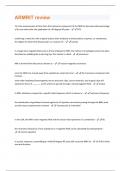
-
ARMRIT review Questions and answers
- Exam (elaborations) • 9 pages • 2024
-
- $7.99
- + learn more
T2 is the measurement of time from the transverse component of the NMV to decrease what percentage of its max value after the application of a 90 degree RF pulse - 37% combining a metal ion with a ligand reduces their tendency to bind proteins, enzymes, or membranes, the degree to which they disassociate is a measure of: - toxicity in a large main magnetic field such as those employed in MRI, the motion of a hydrogen proton has been described as wobbling like a spinning top, this motion is ...
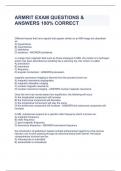
-
ARMRIT EXAM QUESTIONS & ANSWERS 100% CORRECT
- Exam (elaborations) • 36 pages • 2024
- Available in package deal
-
- $10.99
- + learn more
in a large main magnetic field such as those employed in MRI, the motion of a hydrogen proton has been described as wobbling like a spinning top. this motion is called A) precession B) resonance C) frequency D) angular momentum - ANSWER-precession magnetic resonance imaging is derived from the process known as: A) magnetic resonance angiography B) magnetic relaxation imaging C) nuclear magnetic resonance D) nuclear resonance imaging - ANSWER-nuclear magnetic resonance Once the nmv...

$6.50 for your textbook summary multiplied by 100 fellow students... Do the math: that's a lot of money! Don't be a thief of your own wallet and start uploading yours now. Discover all about earning on Stuvia


